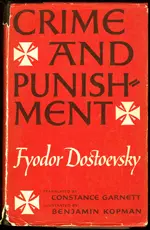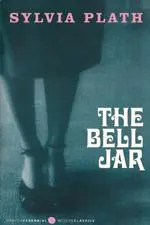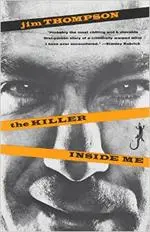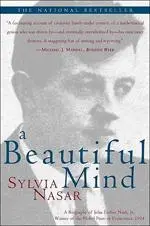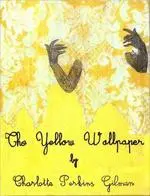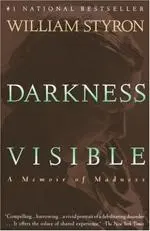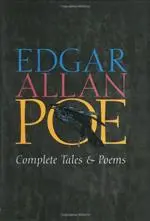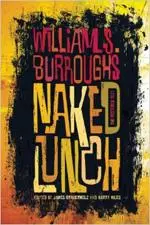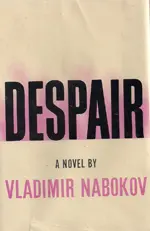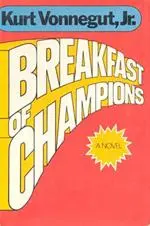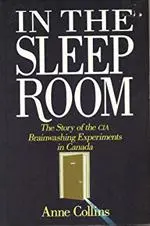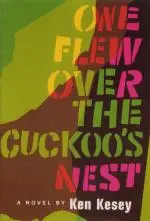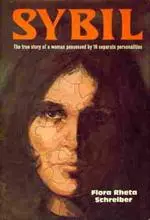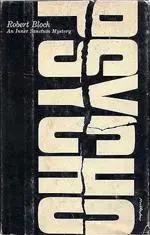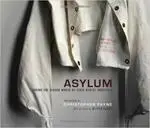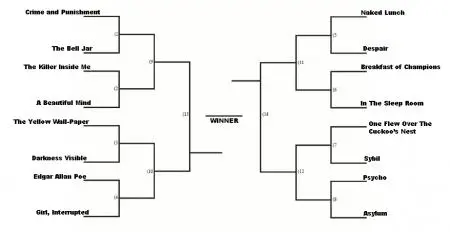Every March, a solid chunk of the US population goes a little mad, as Norman Bates put it. Except it's not at all like the madness he was talking about, but rather a fever pitch over a seemingly never-ending barrage of college basketball games and bracket-based gambling that culminates in a championship game at the end of the month. But this isn't the kind of madness I'm interested in, largely due to the utter madness that is the NCAA (a nasty little subject that John Oliver expertly and eloquently tackled on his show Last Week Tonight). Nor am I all that interested in the bonus March drunken madness of St. Patrick's Day (which, for me, is always first and foremost my parents' wedding anniversary). No, if we want to talk about madness, I'm going to guide the conversation more toward that Norman Bates style of madness mentioned above—the raving lunatic variety; or, at the other end of the spectrum, the tastefully-rendered memoir or biography concerning a person's very real mental grip-slip.
Let's go a little mad...
![]() 1. 'Crime and Punishment' by Fyodor Dostoevsky
1. 'Crime and Punishment' by Fyodor Dostoevsky
Ah, Raskolnikov. Yours is truly a complicated and, when you get right down to it, demented mind, fantastically-rendered and realistic—until, of course, the novel turns toward some kind of morality play. But up until the aftermath of Raskolnikov's crime, Dostoevsky gives readers a marvelous journey into the mind of a man slanting gradually toward murder, mired in rationalizations and justifications like thin veils weakly masking his true desires. Sure, the object of his animosity—his stingy old landlord—is an unpleasant woman, and the wealth she hoards could certainly be put to better use. But at the end of the day, that old Raskol doesn't want to kill her for these reasons, not really; no, he wants to kill her for the sheer sake of committing the gruesome act, and nothing more. His bloodlust is so well-written, in fact, that his guilt after-the-fact feels tacked-on and disingenuous.
![]() 2. 'The Bell Jar' by Sylvia Plath
2. 'The Bell Jar' by Sylvia Plath
The sole novel from writer Sylvia Plath is the very epitome of art imitating life, as Plath was very much in the grips of her own mental health downward spiral prior to and during penning The Bell Jar. There are also several autobiographical parallels between the life of Esther, the novel's protagonist, and Plath's own, the biggest difference being, of course, that Esther manages to survive her depression, while Plath, sadly, did not, committing suicide not long after the publication of her book. Given this, however, Plath has left us with a piece of work that earnestly and accurately describes the stifling, suffocating nature of depression, making it a worthwhile read not merely because it offers a window into a troubled author's mind.
![]() 3. 'The Killer Inside Me' by Jim Thompson
3. 'The Killer Inside Me' by Jim Thompson
Stanley Kubrick referred to this gritty crime noir as, "Probably the most chilling and believable first-person story of a criminally warped mind I have ever encountered." Indeed, Thompson's unflinching exploration into the gut-churning corridors of Deputy Sheriff Lou Ford's head surpasses Dostoevsky's work on Crime and Punishment by leaps and bounds. The character makes Raskolnikov look like a thirteen year-old shoplifter of bubblegum. Why? Because he never once questions his deeds. He doesn't break out into guilt-drenched sweats over the things he's done. He more or less accepts who he is—or, more appropriately, what he is. Eat your heart out, Dostoevsky.
![]() 4. 'A Beautiful Mind' by Sylvia Nasar
4. 'A Beautiful Mind' by Sylvia Nasar
You might be more familiar with the Ron Howard-directed biopic of the same name starring Russell Crowe as John Forbes Nash, Jr., an economist and mathematician who, despite suffering from severe paranoid schizophrenia that nearly ruined his career, won the Nobel Prize in Economics in 1994. While the film is perhaps visually extravagant in its portrayal of mental illness, both it and Nasar's biography attempt to draw distinctions between eccentricity and madness, and, like Plath with The Bell Jar, reiterate the sanity light at the end of the tunnel.
![]() 5. 'The Yellow Wall-Paper' by Charlotte Perkins Gilman
5. 'The Yellow Wall-Paper' by Charlotte Perkins Gilman
In this classic literary horror chiller, the protagonist—unnamed until the very end, and for solid artistic reasons I will not spoil here—is presumed to be afflicted with a "temporary nervous depression—a slight hysterical tendency," though it becomes perfectly clear that there is nothing particularly wrong with this character other than that she was born a woman. See, Gilman uses insanity and horror to make a broader point about widespread beliefs concerning women—that they are weak, fragile, and of a general temperament necessitating delicate treatment, as though they are sick children instead of perfectly healthy adults. The protagonists's husband John, a physician, thus prescribes a cure that only exacerbates his wife's "illness"—he effectively locks her away in a moldy room with hideous yellow wallpaper, which may or may not harbor something sinister within its patterns...
![]() 6. 'Darkness Visible: A Memoir of Madness' by William Styron
6. 'Darkness Visible: A Memoir of Madness' by William Styron
This autobiography takes its title from John Milton's description of Hell in Paradise Lost: "No light; but rather darkness visible / served only to discover sights of woe, / Regions of sorrow, doleful shades, where peace / And rest can never dwell, hope never comes..." Styron suffers a bout of serious depression culminating in suicide ideation following his abrupt cessation of alcohol and subsequent abuse of the drug Halcion (used to treat insomnia). Like Esther in The Bell Jar and John Forbes Nash, Jr., Styron eventually beats his illness, and this resultant book explores not only the author's struggles but also the struggles of others, shedding light on a problem more widespread than some might think.
![]() 7. 'Edgar Allan Poe: Complete Tales and Poems' by Edgar Allan Poe
7. 'Edgar Allan Poe: Complete Tales and Poems' by Edgar Allan Poe
You could just about apply any collection by the grandaddy of horror and weird literature here, because unfortunately Poe was himself addled with mental maladies that no doubt contributed to his untimely demise. This collection suits our needs, however, because, well, it features ALL his works, and madness was a central theme to some of his most well-known pieces, including The Tell-Tale Heart, Ligeia, The Fall of the House of Usher, and his seminal poem The Raven.
![]() 8. 'Girl, Interrupted' by Susanna Kaysen
8. 'Girl, Interrupted' by Susanna Kaysen
Another title with a popular film of the same name, Susanna Kaysen's memoir delves into the author's eighteen month stay in McLean Hospital, a psychiatric facility in Belmont, Massachusetts—whose former patients, coincidentally, also include John Nash and Sylvia Plath. Kaysen begins her tale by comparing mental illness to a parallel universe, pointing out the ease with which one can slip down the rabbit hole. The author also later surmises that the concept of sanity is nothing more than a construct invented by "normal" people to bolster their own sense of normalcy—in other words, that insanity is the true "normal"—or, that we all "go a little mad sometimes."
![]() 9. 'Naked Lunch' by William S. Burroughs
9. 'Naked Lunch' by William S. Burroughs
Like Poe, you could probably get away with putting just about any title by William S. Burroughs on this list, because the author was kinda nuts (most creative types are). And while Naked Lunch isn't directly about madness, Burroughs's cut-up process combined with nonchalant dips into nightmare fantasies and just plain weird landscapes creates a reading experience not unlike slipping down—way, way down—into one of Kaysen's rabbit holes, a nice little jaunt into the realms of dream and insanity. Naked Lunch is less novel, more depraved, grotesquely hilarious and unnerving funhouse ride.
![]() 10. 'Despair' by Vladimir Nabokov
10. 'Despair' by Vladimir Nabokov
Apparently devised as a kind of parody of Dostoevsky's The Double and Crime and Punishment, Despair concerns itself with Hermann Karlovich, who partners with a man named Felix—whom Hermann believes to be his doppelgânger—to devise "the perfect crime." To reveal any more of the plot would get into spoiler territory, but it's safe to say that things don't work out quite the way Hermann planned them. Moreover, Despair's protagonist is decidedly more deluded—and thus more unnerving—than Nabokov's more famous character, Humbert Humbert from Lolita.
![]() 11. 'Breakfast of Champions' by Kurt Vonnegut
11. 'Breakfast of Champions' by Kurt Vonnegut
Doubles are also explored in this Vonnegut novel, as are the binaries of sanity and insanity touched upon by Kaysen above. Breakfast features dual narratives starring Dwayne Hoover, a Pontiac salesman in Midland City, Michigan—a seemingly "normal" man with a "normal" house, wife and son—and Kilgore Trout, an obscure science fiction writer who by all appearances looks and acts batshit insane. But looks can be deceiving, and Vonnegut reveals that it is Hoover, not Trout, who is truly unstable and even dangerous. The salesman becomes obsessed with one of Trout's novels, believing the book to be about him directly; because of this belief, Hoover falls into full-on cuckoo territory and goes on a non-lethal but no-less catastrophic rampage that is alternately funny and deeply unsettling.
![]() 12. 'In The Sleep Room' by Anne Collins
12. 'In The Sleep Room' by Anne Collins
In The Sleep Room explores the deplorable experiments by one Dr. Ewen Cameron of Allan Memorial Institute of McGill University in Montreal, Canada. Cameron developed his "psychic driving" method as a means of treating schizophrenia, and the process involved using LSD, paralysis, repetitive phrases or sounds to break people down to an effectively infantile mental level, then "rebuild" their minds from the ground up. This might sound like the actions of a mad scientist in a sci-fi movie, but it actually happened—and it was all funded by the CIA as part of their MKULTRA research. Even worse, most of the patients admitted to Cameron's care were suffering anxiety disorders or postpartum depression, and most of the "psychic driving" they endured was performed without their full consent, resulting in issues as varied as incontinence, amnesia, and forgetting how to talk, making these patients far worse than when they sought treatment.
![]() 13. 'One Flew Over The Cuckoo's Nest' by Ken Kesey
13. 'One Flew Over The Cuckoo's Nest' by Ken Kesey
Yes, there's the 1975 film starring Jack Nicholson as R.P. McMurphy, a role that garnered the actor an Academy Award (the movie swept the Oscars that year), but the film fails to really capture the deeper social commentary of the novel. And while this book hasn't exactly aged well—it's REALLY misogynistic for one thing, a fact the author admits—it is worthwhile to read of Chief Bromden's concept of the Combine (scrapped entirely from the film) and its accompanying Burroughs-inspired visions of terror and depravity.
![]() 14. 'Sybil' by Flora Rheta Schreiber
14. 'Sybil' by Flora Rheta Schreiber
Yes, there was a TV movie based on this book that starred Sally Field as the much-maligned title character, who suffered from an extreme case of dissociative identity disorder (also known as multiple personality disorder). Sybil (a pseudonym for Shirley Ardell Mason) manifests sixteen distinct personalities throughout the narrative, each one an expression of various aspects of Sybil's primary, "true" self. There have been more than a few holes punched into this narrative, with many suggesting the author (also Mason's therapist) implanted false memories in her patient in order to make a more compelling book; others still theorize the entire narrative was fabricated by Mason and Schreiber. Whether true or not, this tale taps into the universal fear of losing touch with one's own identity, and for that it remains a classic of the psychological drama genre.
![]() 15. 'Psycho' by Robert Bloch
15. 'Psycho' by Robert Bloch
You knew this one had to be coming. I mean, Norman Bates's line about everyone going a little mad has been referenced three times in this column now, and if we're talking about iconic fictional madmen, Bates takes the cake. Like so many other titles on this list, you might be more familiar with Alfred Hitchcock's stellar film adaptation, but Bloch's original novel is equally worth checking out, not the least because it offers a more thorough window into Norman's twisted mind. The first chapter alone features the character reading a description of a cachua dance, whereby Incan warriors would flay the skin of an enemy, stretch the stomach and beat on the organ as though it were a drum, the sound emitting from the corpse's gaping mouth. Bates finds such macabre delight in the image.
![]() 16. 'Asylum: Inside the Closed World of State Mental Hospitals' by Christopher Payne
16. 'Asylum: Inside the Closed World of State Mental Hospitals' by Christopher Payne
The lone non-narrative title on this list, Asylum features photographs of deinstitutionalized and abandoned mental health facilities across the nation—the places where madness not only dwelt, but where it was treated, for better or worse. From the book's description via Amazon: "From the mid-nineteenth century to the early twentieth, over 250 institutions for the insane were built throughout the United States; by 1948, they housed more than a half million patients. The blueprint for these hospitals was set by Pennsylvania hospital superintendent Thomas Story Kirkbride...[who] believed that well-designed buildings and grounds, a peaceful environment, a regimen of fresh air, and places for work, exercise, and cultural activities would heal mental illness. But in the second half of the twentieth century, after the introduction of psychotropic drugs and policy shifts toward community-based care, patient populations declined dramatically, leaving many of these beautiful, massive buildings—and the patients who lived in them—neglected and abandoned."

About the author
Christopher Shultz writes plays and fiction. His works have appeared at The Inkwell Theatre's Playwrights' Night, and in Pseudopod, Unnerving Magazine, Apex Magazine, freeze frame flash fiction and Grievous Angel, among other places. He has also contributed columns on books and film at LitReactor, The Cinematropolis, and Tor.com. Christopher currently lives in Oklahoma City. More info at christophershultz.com
